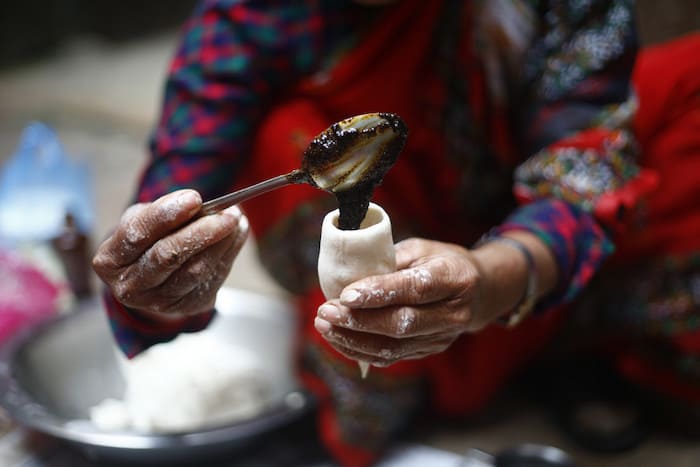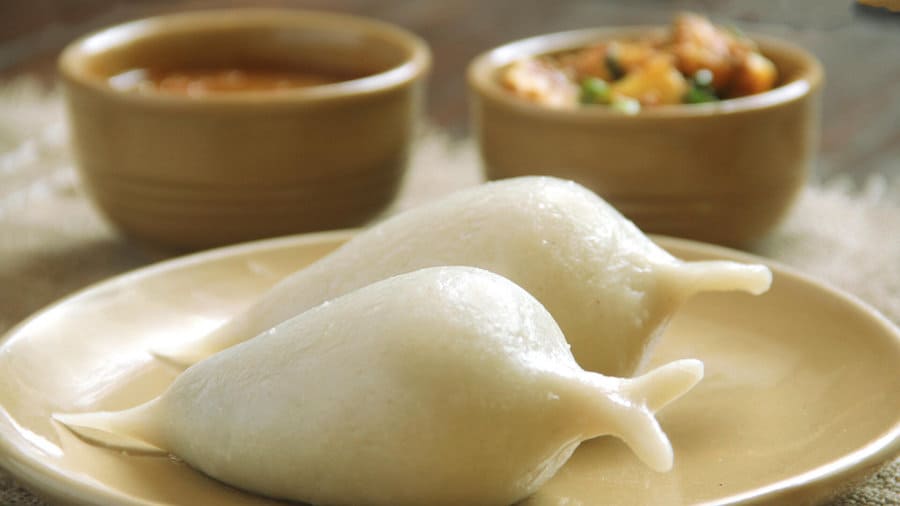Like any other festive delicacy of the Newar community, Yomari represents the community’s culture and tradition. Celebrating Yomari Punhi on a full moon night in December, is an important celebration of the Newars.
It is also known as Dhanya Purnima – in Sanskrit – the festival begins by offering rice to the goddess of grain “Annapurna”. They extend their gratitude towards the goddess by making a dessert “yomari” – a steamed fish like shaped dumpling filled with jaggery taffy (chaku) and sesame seeds or with khuwa (condensed milk solids) and shredded coconut.
As far as festivals in Nepal go, Dhanya Purnima, and celebrating with delicious Yomari treats means good times with family, friends and your community.
Dhanya Purnima: Celebrating with Yomari treats
The older members of the family get together and make Yomari while the younger ones go around the neighborhood singing and asking for Yomari! Families make different shapes of Yomari which also includes shapes of gods and goddesses such as Ganesh, Laxmi, Saraswati and Kubera, and place it on a grain basket used for storing. This is offered as an appreciation of the gods, and thanking them for a good harvest.
If you go around the Newar towns in the city, locals will give different versions of the origin of the Yomari. Legend has it that a couple in Panauti prepared this form of delicacy and distributed it to their neighbors. The neighbors loves the delicacy and hence names it “Yomari”. The Newa word “ya” means “to like” and “mari” to “roti or flatbread”.
Adding more to the story, the god of wealth – Kubera had visited the village in the form of a beggar and was also given yomari. He was happy with the couple’s generosity and blessed them with wealth and prosperity. He told the couple that anyone who prepares Yomari in the form of gods and goddesses on a full moon day will be blessed with wealth and prosperity. Therefore, since that day it is believed that the Newars started to celebrate the festival.
The Delicious History of Yomari:
However, according to the “Social History of Nepal” book, it has mentioned that the people of Kathmandu started making Yomaris from the 6th CE, during the Amshuverma period. The authors of the book also suggested that the Newars might have adopted the culture from Tibetans and even further north, Korean, which prepared similar sweets like the Yomari.
But there’s also a possibility that Yomari got its roots from a similar Indian sweet dish – modaka. Considered as one of the most ancient sweets in India, it is rice flour dumpling filled with jaggery and coconut. As it is a well known fact that cultures can’t thrive in isolation, it is no surprise that maybe some Newar sweets have been influenced by our neighbors, India. For instance, dish such as the jeri and halwa also have Persian roots that travelled via India.
The sweet may have been influenced by the modak, but the shape of the and the filling of the yomari makes it unique to their culture. Newars use chaku (pulled jaggery taffy) instead of jaggery and mould the delicacy into a teardrop or fish shape without the pleats. People have different assumptions about the yomari’s shape. Some refer to it as a fish and others as a shrine of the temple. But, the story doesn’t end here. The yomari’s shape is also linked to one of the wise fruits – the citron.
When is the Newar Sweet Eaten?
Yomari is not only eaten during the Yomari Punhi but other occasions as well. Parents feed pregnant daughters and also prepare the sweets to celebrate even-numbered birthdays of children until they are 12.
During the Yomari Punhi, people prepare mayo and bayo yomari. Mayo is filled with black lentils which symbolizes the female sex organ and bayo is filled with chaku and sesame seeds which symbolizes the male sex organ. These two yomaris are a symbolic representation of two sexes, and the “yomari phonegu” is a practice considered to be a meeting of lovers and seeking romance.
Like any other Newari dishes, the yomari also represents rich newar culture and traditions that brings history, stories, legends and flavor on the table.
How To Make Yomari

Yomari is a steamed rice flour dumpling filled with chaku (jaggery taffy) or khuwa (condensed milk solids). Chaku is eaten during the first day of the Nepali month, Magh (December-January), known as Maghe Sankranti or Ghya Chaku Sanhlu. Yomari Punhi is celebrated around winter solstice and Ghya Chaku Sanhlu marks the end of winter. Chaku is consumed especially during winters as it keeps the body warm and gives energy.
Chaku Yomari Recipe:
Ingredients
- 2 cups of flour
- ⅓ cup of all-purpose flour
- 2 cups jaggery taffy
- ½ cup roasted sesame seed
- ½ cup roasted cashew nuts
- ½ cup shredded coconut
- 2 tbsps ghee (clarified butter)
- ½ cup milk
- ½ cup lukewarm water
How to prepare jaggery for Chaku Yomari:
To make the chaku Yomari, sugarcane jaggery is boiled until caramelized. Then the warm sticky mass is pulled and stretched multiple times until it becomes smooth and glossy. The consistent stretching and pulling of the jaggery changes the color from dark to brown, making it glossy and aerates to make it light and chewy. Caramelization helps to create the light bitterness that helps to balance the sweetness of jaggery.
Steps to:
Prepare jaggery
- Heat a deep bowl at high temperature and put jaggery and sesame in it
- Let the jaggery melt and keep stirring it with a spoon continuously so that it doesn’t burn
- Add crushed sesame seeds, shredded coconut, cashew nuts and tablespoon of rice flour
- Add a cup of water or milk and stir it again for a few minutes
- If the jaggery is sticky then you remove it from the stove or continue stirring it until its ready
Prepare dough
- In a bowl, add rice flour and all purpose flour and mix it well
- Add warm water and knead well to make the dough soft. Then, cover it and let it rest for 10 minutes
Making Yomari
- Apply oil in your hand to make sure that the dough doesn’t stick to your hand
- Make them round and slowly turn them into a cone-shape without making any holes are the bottom
- Then dip you forefinger into warm water with ghee or oil and press down gradually to make a deeper or a bigger hole to create a cavity
- Then add melted jaggery with sesame seeds, making sure that the cavity is only half filled. Then hold the mouth of the hole and start closing the upper part of the cone using your forefinger and thumb.
- Then steam the Yomari in a steamer for 10-15 minutes.
Khuwa Yomari Recipe
All the ingredients are the same except replace the chaku with khuwa and add sugar. Additionally, follow the same process for making khuwa yomari as well! However, the process for preparing Khuwa is a little different than chaku.
Prepare Khuwa filling for Yomari (condensed milk solids)
- Boil a cup of milk and add one small sized bowl of khuwa
- Stir it until the lumps are completely dissolved and forms a smooth paste
- You can add shredded coconut and one tbsp of sugar and stir it
- Then add one tbsp of ghee (clarified butter) to enhance the flavor of the khuwa and stir to ensure that every ingredient is mixed together
- After the filling is ready, pour it to a bowl and let it cool down
Yomari tastes better when eaten hot. I love the blend of sweet bitterness of Chaku and nuttiness of the roasted cashew nuts, coconuts and sesame seeds! Yomari can be found in any Newari restaurants in the city, so go ahead try one of them!
If you’re a foodie and looking to try food in Nepal, check out our blog to find the traditional food in the city! Or if you are a little more adventurous, you can try the weirdest food in Nepal!
